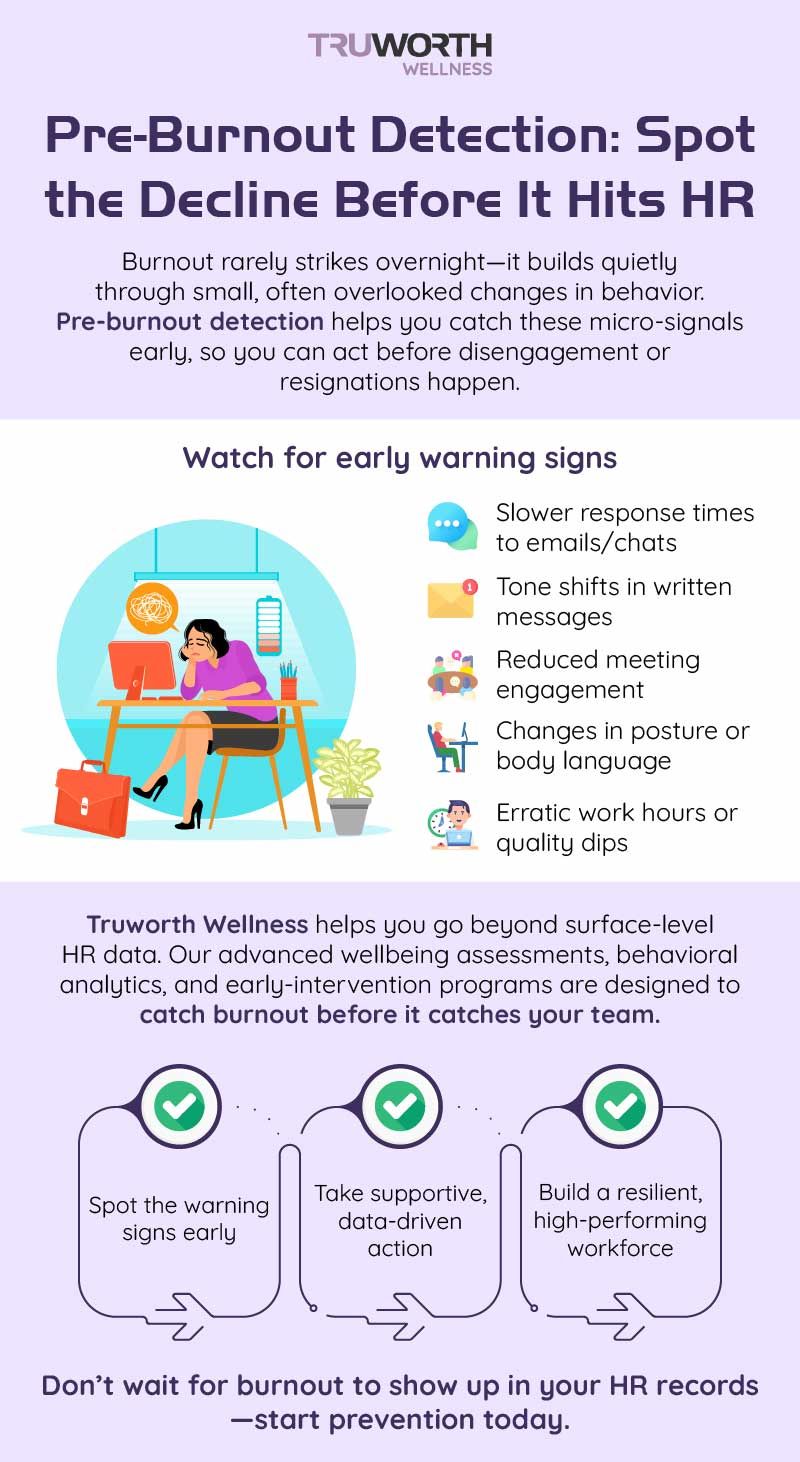Pre-Burnout Detection: How To Spot Decline Before It Hits HR Records?

Burnout is only noticed once it’s too late—when productivity nosedives, absenteeism spikes, or an employee finally says, “I can’t do this anymore.” By then, the damage is done—not just to the individual, but to team morale, client relationships, and even the company’s bottom line.
But what if you could see the signs before they made it to HR records?
What if instead of waiting for disengagement surveys, medical claims, or exit interviews, you could spot micro-signals of decline—small but telling changes in behavior—that quietly flag when someone is sliding toward burnout?
Welcome to pre-burnout detection—a proactive, data-informed approach to protecting your workforce’s mental health.

Why Pre-Burnout Detection Matters?
Burnout doesn’t just appear overnight. It’s a slow drip of cognitive strain, emotional depletion, and disconnection from work.
The earlier you spot it, the more you can do to reverse course—through support, workload adjustments, or wellbeing interventions—before the problem becomes chronic or irreversible.
Think of it like preventive health checkups: you don’t wait for a heart attack to start caring for your heart. In the same way, organizations shouldn’t wait for a resignation letter to start caring for mental health.
The Micro-Signals That Reveal Decline
Traditional HR metrics—like attrition rates, absenteeism, or engagement scores—are often lag indicators. By the time they change, the burnout damage is already deep.
Pre-burnout detection focuses on leading indicators, subtle shifts that can surface weeks or months earlier. Some of the most telling signs include:
1. Response Time and Communication Lag
The signal: Emails, chat messages, or task updates take longer to respond to than usual, even from typically prompt employees.
Why does it matter? Mental fatigue slows cognitive processing and decision-making, making even simple responses feel like effort.
2. Tone Shift in Written Communication
The signal: A once-collaborative communicator becomes curt, overly formal, or drops social niceties.
Why does it matter? Tone changes can reflect declining emotional bandwidth, irritation, or detachment.
3. Meeting Engagement Drop
The signal: Cameras stay off more often, contributions dwindle, or an employee multitasks instead of engaging.
Why does it matter? Reduced participation often signals emotional exhaustion, disconnection, or quiet disengagement.

4. Changes in Posture and Physical Demeanor
The signal: Slouched posture, reduced eye contact, or tense body language during in-person or video calls.
Why does it matter? The body often signals strain before the mind consciously acknowledges it.
5. Erratic Work Patterns
The signal: Sudden bursts of late-night work, inconsistent productivity, or unusual task prioritization.
Why does it matter? These patterns may reflect sleep disruption, overcompensation, or inability to maintain focus.
6. Quality Fluctuations
The signal: Small errors increase, attention to detail drops, or the usual standard of work isn’t maintained.
Why does it matter? Cognitive overload can compromise performance long before an employee consciously says they’re overwhelmed.
The Role of Behavioral Analytics
This is where HR tech steps in—not to spy, but to support.
Behavioral analytics platforms can unobtrusively track and flag these micro-signals over time, integrating data from:
- Communication platforms (response patterns, tone analysis)
- Collaboration tools (meeting engagement levels, participation rates)
- Wellness apps (self-reported mood or stress scores)
- Ergonomic sensors or AI-based posture tracking (for in-office or hybrid setups)
The key is ethics—employees must know what’s being measured, why, and how it benefits them. Data should be anonymized, aggregated where possible, and used to initiate supportive conversations, not disciplinary action.

From Detection to Action
Spotting the signs is only half the battle. What you do next determines whether the employee rebounds or spirals.
- Early Check-Ins: Encourage managers to have quick, compassionate conversations when small changes are noticed.
Example: “I’ve noticed you’ve been quieter in meetings—everything okay?” - Workload Realignment: Adjust project loads, deadlines, or task complexity to relieve pressure.
- Access to Mental Health Resources: Ensure counseling, EAPs, or wellness programs are easy to access without stigma.
- Encourage Recovery Time: Promote short breaks, flexible hours, or mental health days when early signs appear.
- Ongoing Monitoring: Continue tracking indicators post-intervention to ensure recovery is sustained.

The Prevention Payoff
Organizations that adopt pre-burnout detection often see:
- Lower turnover and absenteeism
- Improved team morale
- Stronger employer brand (as word spreads that employee wellbeing is a real priority)
- Higher sustained productivity without pushing people to their limits
It’s a shift from reactive firefighting to proactive wellbeing stewardship—and it pays off in both human and business terms.
Also Read: The 5-Day Workweek As a Wellness Tool: Fantasy or Feasible?
Truworth Wellness: Your Partner in Early Burnout Prevention
At Truworth Wellness, we help companies go beyond the obvious HR metrics.
Our behavioral wellbeing assessments, mental health check-ins, and tech-enabled monitoring tools are designed to spot those early micro-shifts in performance, communication, and wellbeing, long before burnout takes hold.
With our tailored interventions, you can protect your most valuable asset: a healthy, engaged workforce.
Bottom Line
Burnout doesn’t have to be a surprise.
With the right combination of behavioral awareness, ethical analytics, and compassionate leadership, you can detect the whispers of decline before they become cries for help.


